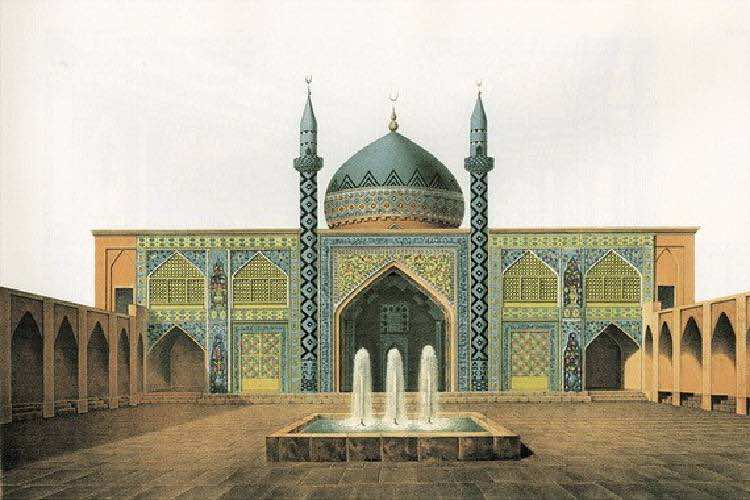The concession of Iravan to Armenia as a political center
 Throughout its history, Iravan has been one of the oldest cultural centers in the Caucasus, with most of its population being Azerbaijani. In the late 18th and early 19th centuries, the Iravan Khanate had a strategic position between the Ottoman and Qajar empires. In 1828, the Iravan Khanate was incorporated into the Russian Empire with the Treaty of Turkmenchay, concluded as a result of the Russo-Iranian War.
Throughout its history, Iravan has been one of the oldest cultural centers in the Caucasus, with most of its population being Azerbaijani. In the late 18th and early 19th centuries, the Iravan Khanate had a strategic position between the Ottoman and Qajar empires. In 1828, the Iravan Khanate was incorporated into the Russian Empire with the Treaty of Turkmenchay, concluded as a result of the Russo-Iranian War.
As part of Russia's Caucasian policy, especially from 1828 to 1830, tens of thousands of Armenian families were resettled from Iranian and Ottoman lands to Iravan and surrounding regions. As a result of these demographic changes, the Armenian population in the city of Iravan and its governorate began to increase toward the end of the 19th century. However, even before 1917, a significant portion of the population of the city of Iravan itself consisted of Azerbaijanis.
On May 26, 1918, the Transcaucasian Sejm dissolved itself and declared the independence of Georgia. On that same day, the Armenian faction of the Sejm approached the Muslim faction regarding the designation of Iravan as the capital for Armenians, as there was no capital for Armenia to declare independence. During a meeting of the Muslim National Council held on May 27, Nasib bey Usubbeyov stated that the Turkish delegation represented at the Batum conference believed that the South Caucasus must preserve its independence and that some territorial concessions should be made to the Armenians to maintain unity and solidarity. On May 28, the independence of both Azerbaijan and Armenia was declared.
On May 29, during a meeting of the Muslim National Council, Prime Minister Fatali Khan Khoyski delivered a report on the negotiations regarding the borders between the two republics with representatives of the Armenian National Council. Khoyski stated that the Armenians required a political center, but following the transfer of Alexandropol (Gumru) to Turkey, such a center could only be Iravan. The meeting assessed the concession of Iravan as a political center to Armenia as a historical necessity and an inescapable misfortune. Of the 28 members of the National Council present, 16 voted in favor of conceding Iravan to the Armenians, one voted against, and three remained neutral. However, the Iravan Muslim National Council immediately objected to this concession. In the June 1 meeting of the National Council, members from Iravan, Mir Hidayat Seyidov, Baghir Rzayev, and Nariman bey Narimanbeyov, formally submitted their written protests against the decision to concede Iravan to Armenia, but their objections had no effect.
On June 4, 1918, a treaty of peace and friendship was signed between Turkey and Armenia in Batum. According to this agreement, the territory of the Republic of Armenia covered approximately 9,500 square versts, with a population of 321,000 (including 230,000 Armenians, 80,000 Muslims, 5,000 Yezidi Kurds, and 6,000 people of other nationalities). The republic's territory included the Novo-Bayazid district, three-fifths of the Iravan district, one-fourth of the Echmiadzin district, and one-fourth of the Alexandropol district. Despite the concession of the city of Iravan to Armenia, Armenian armed groups sought to expand the republic's territory by seizing Azerbaijani-populated areas in the surrounding regions through military force.
The decision of the Azerbaijan Democratic Republic to cede Iravan to the Armenians was a complex and challenging one from both political and historical perspectives. However, within the context of the geopolitical realities of the time, it was deemed a necessary choice. While this step contributed to the international recognition of the ADR, the establishment of the state, and the provision of temporary stability in the region, it also resulted in the loss of a significant part of the historical and cultural heritage of the Azerbaijani people. Even today, this decision remains one of the most discussed and deeply analyzed events in Azerbaijani history.
Recommended literature:
- İrəvan xanlığı : Rusiya işğalı və ermənilərin Şimali Azərbaycan torpaqlarına köçürülməsi: monoqrafiya / Y. M. Mahmudov [et al.] ; elmi red. Y. M. Mahmudov ; AMEA A.A. Bakıxanov adına Tarix İnstitutu, Regionların İnkişafı İctimai Birliyi. - Bakı : Azərbaycan nəşriyyatı, 2010. - 616 s.
- İrəvan xanlığının tarixi = История Иреванского ханства = History of the Irevan Khanate / tərt.-müəl. Z. Hacıyeva. - Bakı : n. y., 2013. - 105 s.
- Mustafa, Nazim. İrəvan quberniyasında azərbaycanlıların soyqırımı: 1918-1920 / N. Mustafa; layihənin rəh., ön sözün müəl. Y. M. Mahmudov; AMEA A.A. Bakıxanov adına Tarix İnstitutu.- Bakı: Elm, 2017.- 328 s.
- Nəcəfli, Güntəkin Cəmil qızı. Şərqi Anadolu, Naxçıvan və İrəvan bölgələrində ermənilərin türk-müsəlman əhaliyə qarşı törətdikləri soyqırımlar: 1918-1920 / G. C. Nəcəfli; layihənin rəh., ön sözün müəl. Y. Mahmudov ; AMEA A.A. Bakıxanov adına Tarix İnstitutu.- Bakı: Elm, 2017.- 248 s.
- The Iravan Khanate : the Russian occupation and the relocation of Armenians to the lands of North Azerbaijan / Y. M. Mahmudov [et al.] ; trans. B. Hajiyev ; ed.: Y. M. Mahmudov, T. Mustafazadeh ; Institute of History named after Abbasgulu Agha Bakikhanov of the ANAS. - Baku : Azerbaijan, 2010. - 608 p.